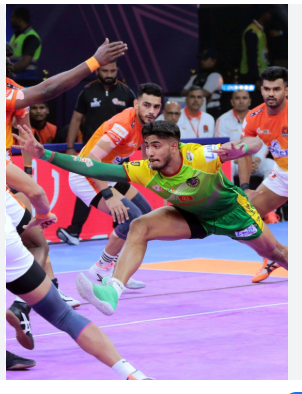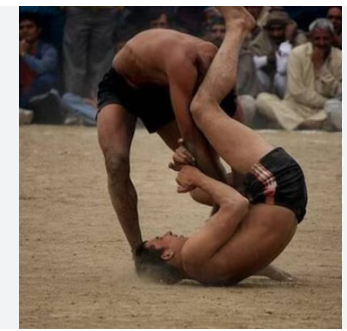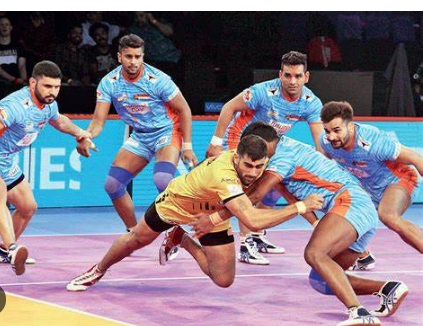Kabaddi traditional Indian sport of kabaddi has existed for over 4,000 years. Kabaddi started as combat training for warriors. It helped them build agility, endurance, and mental focus. The main rule about holding your breath during an invasion has stayed the same since the sport began.
Started as a rural sport in India. Now, it has grown into a professional game. It features organized leagues and international tournaments. In the last twenty years, South Asian kabaddi has grown. It now includes players and fans from Iran, South Korea, and recently, Europe.

The Rules: A Game of Strength, Speed, and Strategy
Kabaddi is played between two teams of seven players on a rectangular court. In the game, an offensive player called the raider moves into the opponent’s half. They try to tag as many defenders as they can before returning to their side. They must do this in one breath. Meanwhile, defenders attempt to stop the raider from escaping.
Teams score points for successful raids. Defenders earn points by tackling the raider. A player who gets eliminated can return to the game if their team scores a point. Matches consist of two 20-minute halves. Pro leagues have set clear rules. This makes gameplay smoother and boosts excitement.
If this sounds familiar, you’ve likely spent hours watching kabaddi matches. You might even be a player yourself! In any case, your knowledge can now become an advantage. You can make money on the online betting platform in India by predicting the outcomes of major kabaddi tournaments. Bet on your favorite team and earn real rewards. It’s never been easier to monetize your passion!
From Villages to Stadiums: The Evolution of Kabaddi
Began in rural India, played in open fields with few or no formal rules. It stayed popular for many years in Indian states such as Punjab, Tamil Nadu, and Maharashtra. India started its journey toward kabaddi regulation in the early 20th century. In 1950, it formed a national federation to oversee official competitions.
Key milestones marked the sport’s growth:
-
Asian Games (1990): Kabaddi became an official medal event.
-
World Cup (2004): They held the first international championship.
-
Professional Leagues (2014): Franchise-based formats attracted global attention.
-
Female athletes began participating in international competitions.
Television broadcasts and commercial sponsorships helped kabaddi gain massive popularity. This traditional Indian sport is now played in over 30 countries. It has changed from a village pastime into a global phenomenon.

Kabaddi’s Global Growth: New Teams and Fans Emerging
But the inclusion of South Korea and Iran over the past two decades shows how much its reach has expanded. These teams have become tough competitors for even the strongest Indian franchises.
Is getting more popular. This is due to professional leagues, better media coverage, and youth training programs. Countries like Kenya, Poland, and Argentina now have national kabaddi teams. They compete in world championships. European and North American clubs now hold invitational tournaments. These events help promote the sport and find new talent. Kabaddi is no longer India’s exclusive domain—Iran’s gold medal win in the 2018 Asian Games proved that.
The rise of new competitors has also increased interest among fans and analysts. This competitive boom is a golden opportunity for forecasters and bettors. Melbet, a top online sportsbook for kabaddi, sees yearly growth in kabaddi bets. Today, kabaddi betting is viewed as a low-risk, high-reward chance. This trend keeps growing.
Endurance: A Physical and Mental Test for Players
The players must have a unique mix of strength, speed, agility, and strategy. Athletes train hard to boost endurance and avoid injuries. They do this without wearing protective gear. Defenders use power and coordination to trap raiders. Raiders rely on speed and timing to escape.
Players need to improve their cognitive skills. This helps them see what their opponents will do next. It also considers the opponents’ physical skills. Pro Kabaddi teams now hire coaches, strength trainers, and nutritionists to boost performance.
Kabaddi in the Digital Age: Online Popularity and Expansion
Digital technology has made kabaddi more accessible than ever. Social media platforms help players, teams, and fans connect. They build a strong global community.
Coaches use advanced analytics to change game tactics quickly. Also, virtual training tools help new players learn the game faster. Digital resources are helping kabaddi grow in new countries and regions.
More fans are finding kabaddi online, so the sport’s global recognition is growing.
The Future of Kabaddi: A Sport on the Rise
Started in villages and has now become a well-known sport worldwide. International tournaments, pro leagues, and new training methods have all driven this change.
Technology has increased fan engagement. At the same time, investments in infrastructure and coaching have improved gameplay. Kabaddi isn’t local anymore. It now attracts fans, players, and media from around the world.
Blends athleticism, strategy, and cultural history. It is set to be one of the world’s next big sports.
